|
home: www.rubythroat.org |
|
|
home: www.rubythroat.org |
|
In the U.S, and Canada, it is easy to age and sex Ruby-throated Hummingbirds (Archilochus colubris) in Spring when all the males are adults with red gorgets, and all the females are adults with plain, white throats. After about the first of May--when earliest first hatchlings begin to fledge in the southernmost states--things get complicated because young males lack the distinctive red throat. (Recently fledged young males may, however, have some streaks of dark green or black on the throat.) After early May, a Ruby-throated Hummingbird without a red throat could be an adult female, a young female, OR a young male. To better understand population dynamics, it is important to know the percentages of males and females, so it's fortunate that young birds can be sexed in-the-hand by looking at the sixth primary (flight feather) on the wing (below). In Ruby-throated Hummingbird males of any age this feather is sharply tapered to a point, while in females it is not tapered and the tip is usually rounded.
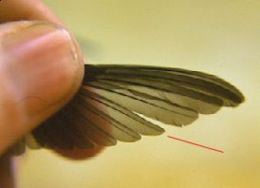
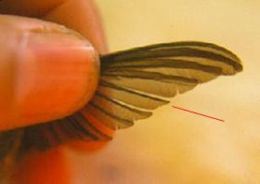
Photos © Bill Hilton Jr.
The sixth primary feather on the wing of female Ruby-throated Hummingbirds (red pointer in left photo) is rounded and untapered, while that of males is tapered and pointed (above right).
Ageing hummingbirds can be even more difficult, but perhaps the best way to determine age is to look at the bill with a hand lens. In young birds, the sides of the upper bill are marked by fine etchings called "corrugations." These etchings begin to disappear beginning at the tip, and after 4-6 months the upper mandible is almost completely smooth. Some adults retain as much as 10% etchings at the base of the bill. Researchers believe the bill becomes smoother in adults because an increased flow of blood "plumps up" or "fills in" the etchings, although the mere action of probing flowers and feeders may contribute.
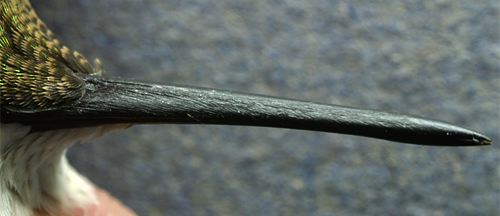
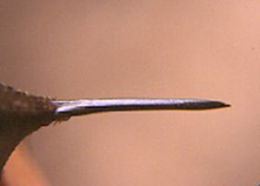
Photos © Bill Hilton Jr.
Although it is difficult to illustrate photographically, the upper bill of a young Ruby-throated Hummingbird (above left) has tiny corrugations or etchings that make it appear rough. Adults (above right) have smooth upper mandibles.
Young birds also have a yellowish-colored gape (corner of the mouth, below) that turns ivory or white in adults. Body plumage differences--including the amount of streaking on the throat--are often very subtle and shouldn't be used as the sole criterion to determine age (or sex). That said, young birds often have brownish edgings to the feathers of their backs and heads (below).
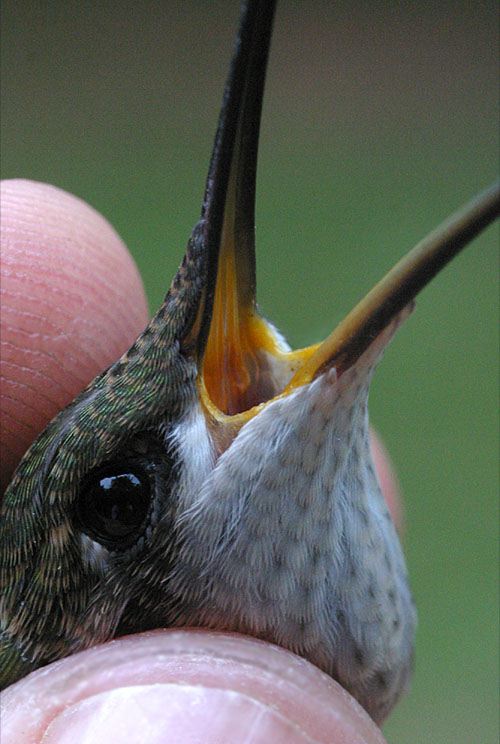
Photos © Bill Hilton Jr.
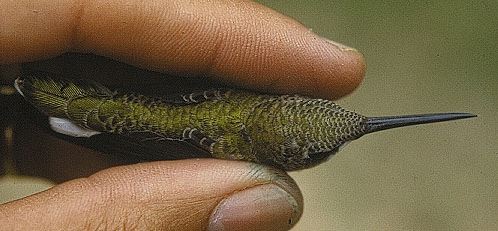
Photos © Bill Hilton Jr.
Back to How Hummingbirds are Banded; forward to Measuring Hummingbirds
Up to Top of Page
|
Make direct donations on-line through
Network for Good: |
 |
|
LIKE TO SHOP ON-LINE?
Donate a portion of your purchase price from 500+ top on-line stores via iGive: |
|
|
Use your PayPal account
to make direct donations: |
|
|
|
Share Your Hummingbird Experiences Through "Hummingbird Hobnob" |
 |
Operation |
|
|